“Fall Guys: Ultimate Knockout” is the best sort of video game chaos.
Its style is as inviting and as brightly lavish as a candy table at a banquet, and its bite-size, mini-game philosophy makes it difficult to stop after a single round. The charm of its addictive ability to merge competition with approachability has made “Fall Guys” the unexpected multiplayer breakout game of 2020 — more than 10 million copies on PC have sold since its August release and it’s the most downloaded game ever on the PlayStation Plus service subscription service.
The titular Fall Guys — jelly bean-meets-Teletubby-meets-Care Bear-like figures — will wobble, hobble and, of course, fall through bouncy obstacle courses inspired by over-the-top, cult-favorite game shows such as “Takeshi’s Castle.” While losing can frustrate, especially when your Fall Guy is close to the finish line of a bubblegum-toned course filled with ramps, seesaws or breakaway doors and is suddenly batted away by a giant spinning hammer, the game still manages to possess a silly, innocent charm.
For the player, its objectives are instantly recognizable on visuals alone — run here, avoid that, steal a tail. Victory goes to the last Fall Guy standing. But this requires surviving a series of courses — or mini-games, each never lasting more than a couple minutes — by racing to a finish, solving simple memory exercises or competing in unpredictably zany team matches.
The completed Egg Scramble round in “Fall Guys.”
(Mediatonic / Devolver Digital)
With more courses and game options landing Oct. 8, we rang up “Fall Guys” level designer Megan Ralph to chat about how a “Fall Guys” course is created. Ralph walked us through a start-to-finish look at how the team arrived at one of her favorite levels, the Egg Scramble, a team-based contest in which each group tries to corral the most eggs. Our first lesson: While “Fall Guys” has become popular because it’s incredibly simple to play, creating a simple game is no simple task.
And it should be noted that team-based games are a contentious topic among the “Fall Guys” community.
With “Fall Guys” matches consisting of up to five mini-game courses, a team bout means that one must suddenly rely on peers to advance to the next round, and possibly become the last Fall Guy left. Yet in a game where wacky pandemonium rules, I’m partial to the team rounds. They serve as a reminder that so much in the “Fall Guys” universe is nonsensical and out of my control, which is a comforting real-life lesson as well.
And besides, Egg Scramble is dear to Ralph’s heart. It was the first level she made for the game.
Also, bunnies were once involved.

An early sketch of Egg Scramble from Megan Ralph. The triangular course was there from the beginning.
(Mediatonic / Devolver Digital)
The initial pitch
The development of new courses for “Fall Guys” has evolved into a formal process that often includes full-team brainstorm sessions at the game’s London-based studio Mediatonic. But when Ralph began working at Mediatonic in summer 2019, there were no such formalities. At the time, she says, the studio had just three courses that were fit for public showing at that year’s Electronic Entertainment Expo.
“They didn’t have a pipeline,” Ralph says of those initial “Fall Guys” rounds. “They didn’t have documentation. They didn’t have diagrams. They came together organically. That’s nice in theory, but we couldn’t go forward with an actual product without having a proper process. That’s what I was trying to establish.”
“Fall Guys” at that point also didn’t have team games, and creating one was an initial assignment given to Ralph. Like all “Fall Guys” courses, player objectives had to be readily clear, so Ralph came up with the core gameplay concept — “fetching and stealing.”
With the understanding that the geometry of the level had “to be intuitive,” Ralph came up with the triangular vision for Egg Scramble.
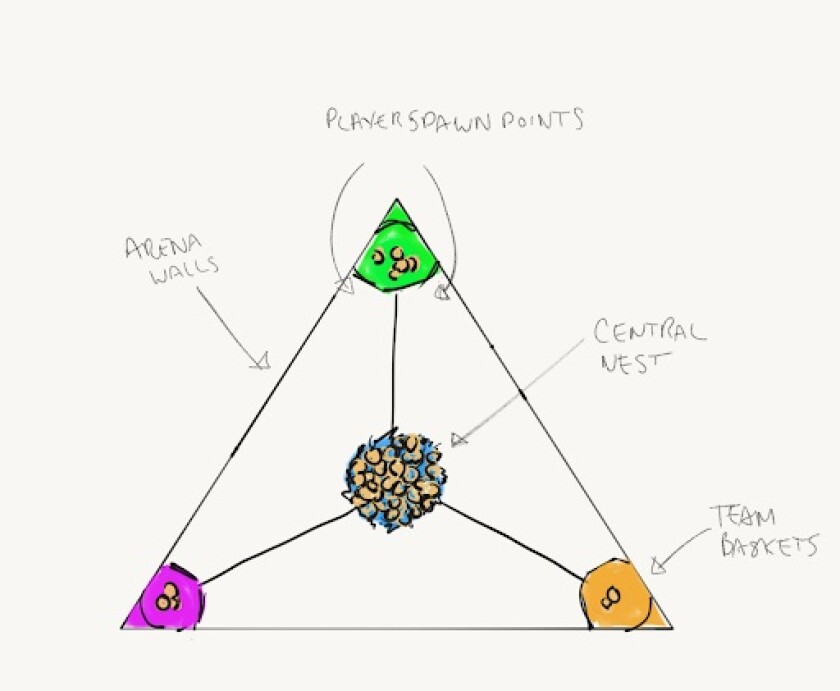
A key reason the Egg Scramble level works is that the triangular shape ensures each team is equal distance to the center nest.
(Mediatonic / Devolver Digital)
In the mini-game, there is a nest of eggs in the center of the course, and each team has to collect as many as possible, all while defending their basket-like base and stealing from others. This design, slanted toward the center nest, allowed each team to have an equal amount of running space to the nest, and should an egg be dropped on the way to a team’s base it would gradually make its way back to the central nest.
“Fall Guys” at this point didn’t have any props. While one course gave players tails and the ability to steal the tails of others, Ralph believed that creating some sort of prop — an egg in this case — and asking the players to fish for them from a central point would make it easy to keep score.
It also allowed her to create a mini-game where the player’s focus can constantly shift.
Does one center on rounding up loose eggs? Or does one concentrate on stealing the eggs of other teams? Or instead, does one act as a guard to keep others out?
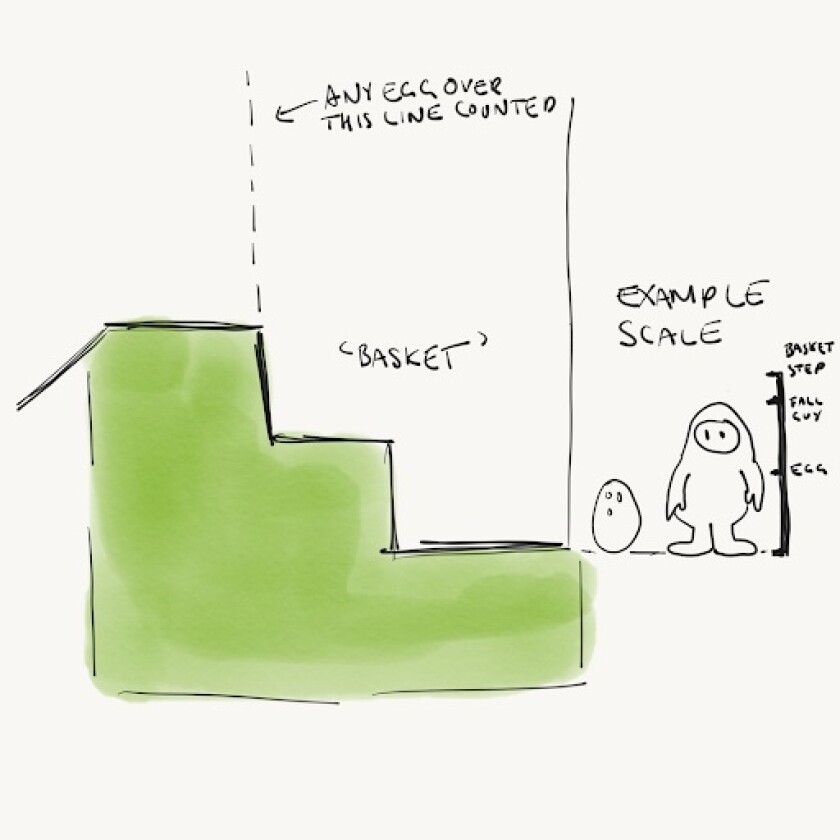
An early attempt by “Fall Guys” level designer Megan Ralph to explain to her coworkers how the nest in Egg Scramble would work. The sketch, she says, was done in a second on her iPad in a meeting.
(Mediatonic / Devolver Digital)
“I really wanted to focus on switching gameplay midway through the round,” says Ralph.
“Everyone is taking eggs out of the central nest for the first half, but in the middle everyone runs out of eggs and they have to steal from other people,” she says. “I liked that switch.”
So did players.
“Now when you watch people play that happens immediately, but when we were testing it there was a defined set of two sections to the level where people would get the eggs and then there would be a tussle. I enjoy that element as it encouraged a bit more interaction between the players and the teams.”
Cameras! Slopes!
Once Ralph feels she has a good handle on a level she’ll write up a single-page pitch. The document will lay out the game mechanics, providing a coder with a sense of how the level will play out, and also include a list of art assets that would be needed. This is shown to the teams in charge of various “Fall Guys” principles.
“We get a programmer and an artist who document,” Ralph says, “and they give it a thumbs-up and say it’s doable or that we don’t have time for this.”
But even when Mediatonic opted to go ahead with Egg Scramble, there were many questions left to solve. In an early 3-D mock-up of the level, back when the game had 100 Fall Guys rather than 60, the gray area in the center was left open because it was unclear at this point in development where the camera would be placed. Preliminary iterations, in fact, had cameras that would remain stationary with the nest of the player’s team centered, as opposed to the roaming, floating ones that are in the final product.
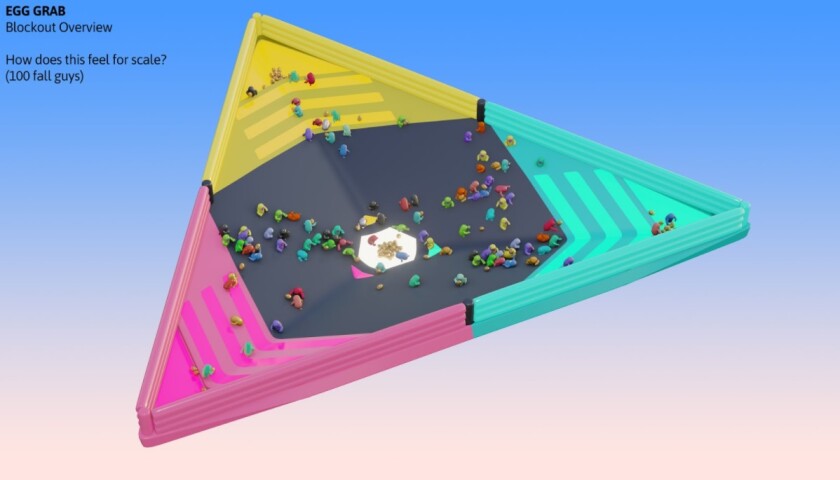
An early 3-D rendering from concept artist Daniel Hoang. At this point in the development the camera was fixed, as noted by the grayed-out area in the center.
(Mediatonic / Devolver Digital)
Some of the thinking was that the player could be hyper-focused on the end goal. A team’s nest would be straight ahead, and competing nests would be tucked in the corner of the screen. Imagine you’re the yellow team. The nests of the pink and blue teams would be on the left and right corner of the screen.
For a bit more detail, one can get a sense of the initial feel in this early full-map rendering from Ralph below. (For a sense of how this would look in the game, scroll down to the nighttime shot.)
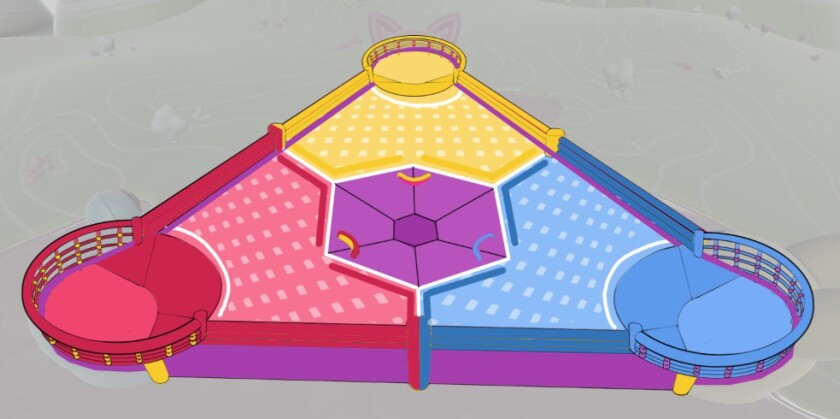
This prototype shows the more open-air baskets that would end up in the final “Fall Guys” level.
(Mediatonic / Devolver Digital)
This image is notable because it also clearly establishes the slopes of the course, allowing the eggs to gradually make their way back to the center nest.
One discarded idea was that an egg would disappear when dropped and essentially respawn in the center of the map. Anyone who has played “Fall Guys” knows that dropping an egg isn’t an “if” but an inevitability, and there’s a delicate balance between challenging and downright frustrating the player.
Other problems came to the fore in trying to simplify the design process. One solution that became clear: the free-roaming camera.
“You would have been able to see your nest quite clearly,” Ralph says of a fixed camera, “but you wouldn’t have got the detail and you wouldn’t have seen the other nests as well.”
It also changed the whole game: “If we wanted to encourage stealing or a shift in gameplay, we had to do something about this, as the fixed camera is focused on [protecting] your base.”
Tokyo at night? And bunnies!
One of the most electric photos Ralph revealed was one that completely deviates from the current “Fall Guys” style. It shows how the level would have been transformed into a part rave, part neon-drenched cityscape with a vibrant, upbeat electronic score courtesy of Daniel Hagström and Jukio Kallio.
Ralph says the inspiration was Tokyo at night.
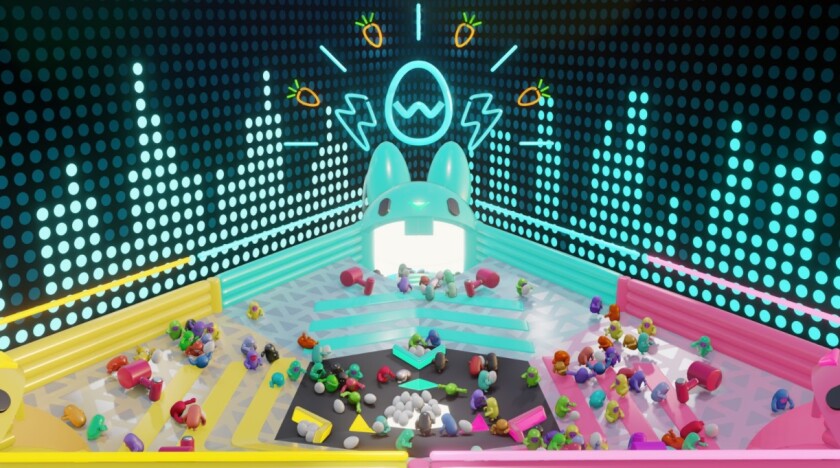
“Fall Guys” once had day-night settings, which would have given Egg Scramble an EDM feel.
(Mediatonic / Devolver Digital)
Yes, “Fall Guys” originally had day-night cycles, which would have completely changed the look of some of the courses.
While this was indicative of the team brainstorming — and perhaps trying to do too much — the night cycles were dropped because it added unnecessary complexity for the developers and players. Lighting became trickier to manage, and the shifting day-night courses, especially the club-inspired nighttime ones, threw too many distractions at the player.
“We wanted those Tokyo neon lights, and a dramatic EDM feeling,” Ralph says. “In the end, we decided to make everything cohesive and light it in a daytime environment. It was better. People were getting lost when we would change the lighting and the vibe of the levels so much.”
Another concept that was dropped: bunnies.
The “Fall Guys” level called Door Dash, for example, has slightly personified portals with eyes and a mouth, so the thinking was to bring a bit of “life” to Egg Scramble. Since bunnies are associated with eggs, team nests were fashioned into bunny mouths; teeth became digital scoreboards.

Rabbits, with scoreboards for teeth? It was a cute idea that the “Fall Guys” designers loved, but was impractical for gameplay.
(Mediatonic / Devolver Digital)
“It was one of our art director’s ideas,” says Ralph. “We had a nest, and he said, ‘Can we make them heads?’ Yes! Let’s give it a go. But it was a nightmare with the camera. We couldn’t get it working the way we wanted. It was a nice visual touch. The eyes would do something fun when you got an egg through, but was obscuring the camera for too long.”
Of course, says Ralph, the bunny concept was “so endearing” that the team really did try to make it work, so much so that they even tinkered with changing eggs to carrots.
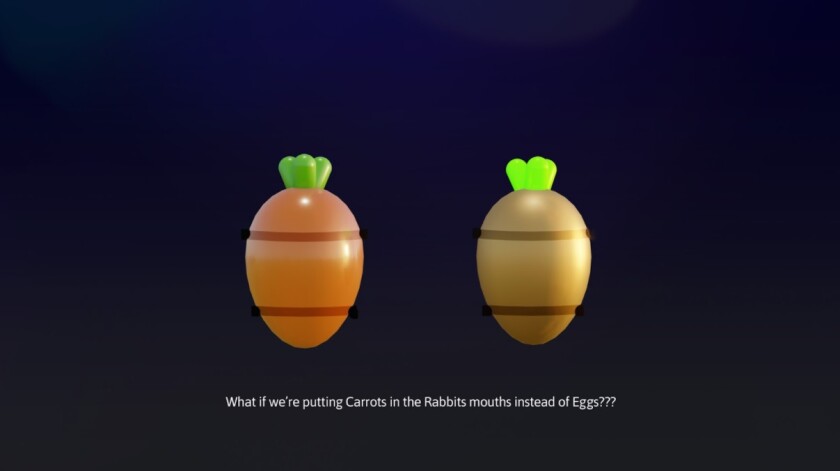
While the final version of Egg Scramble features only eggs, carrots were considered when the nesting areas of the level were made to look like rabbits’ teeth.
(Mediatonic / Devolver Digital)
But the deeper down the rabbit hole the team went, the more problems arose. A digital scoreboard on the bunnies failed to tell players where they stood in relation to other teams. And jumping in out of bunny mouths was proving too cumbersome for the already less-than-athletic Fall Guys.
“It’s so cute,” Ralph says. “It’s just a shame we couldn’t get it working. There’s this stuff called ‘camera collision,’ which basically is I can put an invisible box down that tells the camera to never go in the box. You can zoom in quite close, and we put those around the nests and we were playing with the camera zooming into the head but it was just too jarring.”

A busy nighttime rave-inspired take on Egg Scramble that was not meant to be.
(Mediatonic / Devolver Digital)
So … about those eggs?
Some things in “Fall Guys” are completely random. When a breakaway door in a course is busted through, for instance, those foam-like constructions go bouncing every which way. The eggs, however, required more specificity and control to make the level a success.
“We networked all those eggs, which means we put things on the eggs so the servers know where they are at all times,” says Ralph. “That was a nightmare. Every few months the tech team would come back and say, ‘Can we reduce the egg number?’ I think we ended up with around 40 eggs, but we were very ambitious.”
For most of the “Fall Guys” courses, it doesn’t really matter in which way objects go flying. In fact, that’s part of the charm and it adds to the unpredictability. But having hundreds of eggs for the Scramble was too much of a technical hurdle. Often more than one player attempts to grab an egg at the same time, meaning everything needs to be precise across multiple connections.
“If you drop an egg and someone else grabs it, that has be very accurate on people’s machines,” Ralph says. “So it’s constantly sending messages back and forth to the server. Otherwise, the eggs would look like they’re in different places on everyone’s screen, and that was very difficult.”
That was a key lesson. While the number of eggs was in flux until late in this level’s development, going forward, Ralph says, the tech team was brought into level design conversations significantly earlier. “We had these discussions around the eggs a tiny bit late,” Ralph says.

There’s lots of color in every “Fall Guys” level, but making the eggs all look uniquely painted made the level feel too busy.
(Mediatonic / Devolver Digital)
Then there’s the color of the eggs. In the final game, the eggs look like regular white eggs. But since “Fall Guys” is an explosion of pastel colors, the team initially thought the eggs should be as flamboyant and dramatic as the rest of the game. Bad idea.
“They clashed too much,” Ralph says. “Plus, some of those were team colors, like pink or blue. So they would get lost. Or they would give a team an advantage. We thought we could do different eggs for different teams and we had to rule that out. They weren’t readable, and there was too much visual noise if you tried to create individual eggs.”
The added bonus of making the eggs plain was that the rare “golden” eggs, which are worth more points, stand out.
The finished level may lack bunnies and Tokyo-inspired neon, yet it still feels incredibly vivid. Eggs bounce and roll everywhere, Fall Guys grab anything and everyone, and spinner hammers complicate things. Plus, getting in and out of a nest while trying to steal an egg is no easy feat.
“It was sort of the first 3-D game that the company had worked on,” Ralph says, “and there was a very long muddled process of feedback.”
A level design and early test could usually get up and running within two or three weeks, sometimes longer for the complicated race arenas. “It’s probably about a month of level design time to get the layout designed and approved, and then the artist will take it and do their magic,” says Ralph. “That’s usually an additional probably three weeks. It’s not very long. We can get levels done in two, three months.”
The key, says Ralph, is to keep moving forward even while designs are being worked out.
“I’ve always found if you don’t keep that tight, and keep a record of changes, and get people to justify why you want things changed,” she says, “you go around in circles.”
Anther reason to keep such detailed records: Today’s rejected idea could be tomorrow’s centerpiece. So there’s hope, someday, for bunnies. But why stop at bunnies? What about a pink cat? Or an aqua-blue frog?

This concept rendering shows the Egg Scramble level when it had a fixed camera and when multiple creature heads were considered as egg baskets.
(Mediatonic / Devolver Digital)






